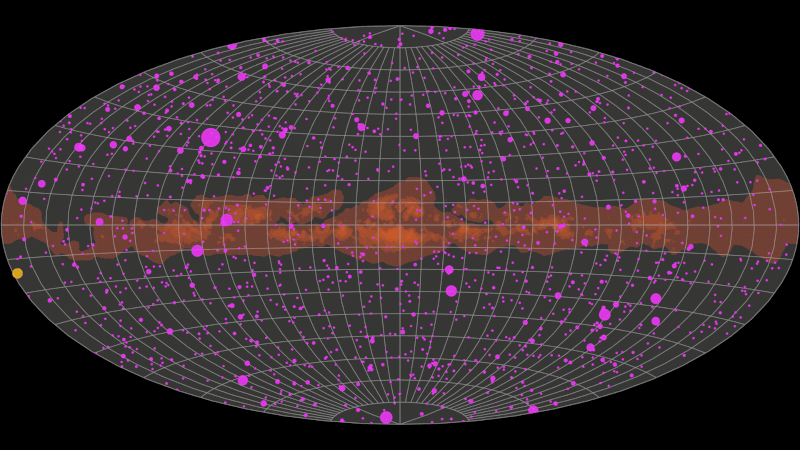File:Fermi LAT LCR Feb2022-Feb2023 Dark 1600.gif

Original file (1,600 × 900 pixels, file size: 6.48 MB, MIME type: image/gif, looped, 120 frames, 9.6 s)
Note: Due to technical limitations, thumbnails of high resolution GIF images such as this one will not be animated. The limit on Wikimedia Commons is width × height × number of frames ≤ 100 million.
Captions
Captions
Summary edit
| DescriptionFermi LAT LCR Feb2022-Feb2023 Dark 1600.gif |
English: Gamma-ray sky’s activity during a year of observations from February 2022 to February 2023 captured by the Large Area Telescope (LAT) aboard NASA’s Fermi Gamma-ray Space Telescope. The pulsing circles represent just a subset of more than 1,500 light curves collected by the LAT over nearly 15 years in space.
Over 90% of the sources in the dataset are blazars, central regions of galaxies hosting active supermassive black holes that produce powerful particle jets pointed almost directly at Earth. Ground-based observatories, like the National Science Foundation’s IceCube Neutrino Observatory in Antarctica, can sometimes detect high-energy particles produced in these jets. Blazars are important sources for multimessenger astronomy, where scientists use combinations of light, particles, and space-time ripples to study the cosmos. In the animation, each frame represents three days of observations. Each object's magenta circle grows as it brightens and shrinks as it dims. Some objects fluctuate throughout the entire year. The reddish orange band running across the middle of the sky is the central plane of our Milky Way galaxy, a consistent gamma-ray producer. Lighter colors there indicate a brighter glow. The yellow circle shows the Sun’s apparent annual trajectory across the sky. |
| Date | |
| Source | https://svs.gsfc.nasa.gov/14309 |
| Author | NASA’s Marshall Space Flight Center/Daniel Kocevski |
Licensing edit
| Public domainPublic domainfalsefalse |
| This file is in the public domain in the United States because it was solely created by NASA. NASA copyright policy states that "NASA material is not protected by copyright unless noted". (See Template:PD-USGov, NASA copyright policy page or JPL Image Use Policy.) |  | |
 |
Warnings:
|
File history
Click on a date/time to view the file as it appeared at that time.
| Date/Time | Thumbnail | Dimensions | User | Comment | |
|---|---|---|---|---|---|
| current | 16:19, 22 March 2023 |  | 1,600 × 900 (6.48 MB) | Artem.G (talk | contribs) | Uploaded a work by NASA’s Marshall Space Flight Center/Daniel Kocevski from https://svs.gsfc.nasa.gov/14309 with UploadWizard |
You cannot overwrite this file.
File usage on Commons
There are no pages that use this file.
File usage on other wikis
The following other wikis use this file:
- Usage on en.wikipedia.org